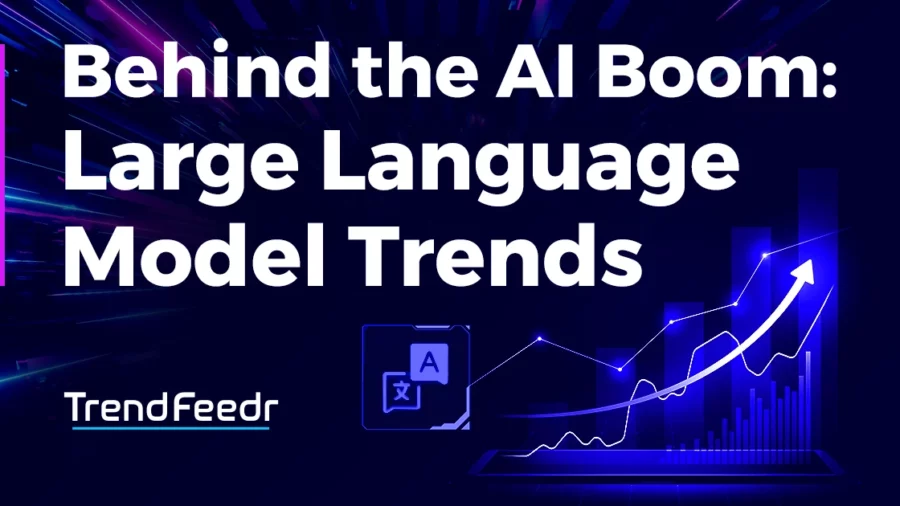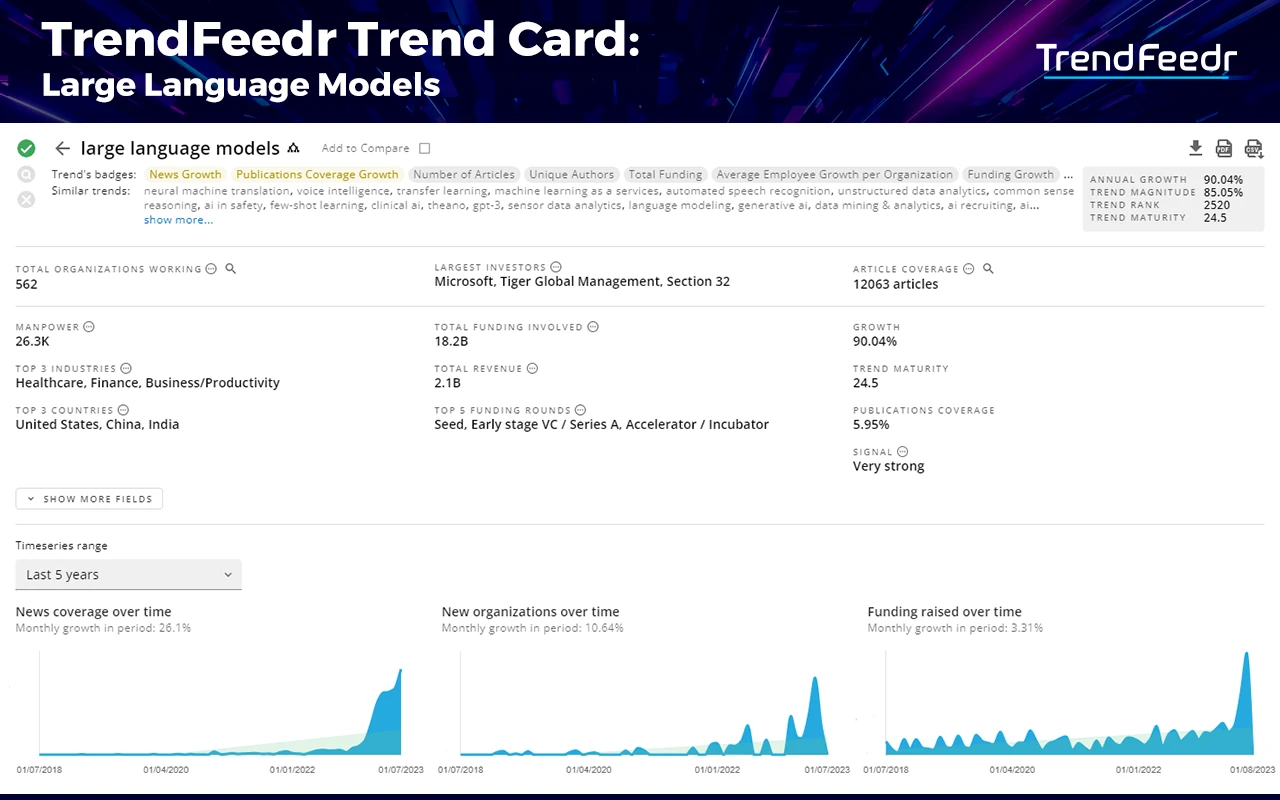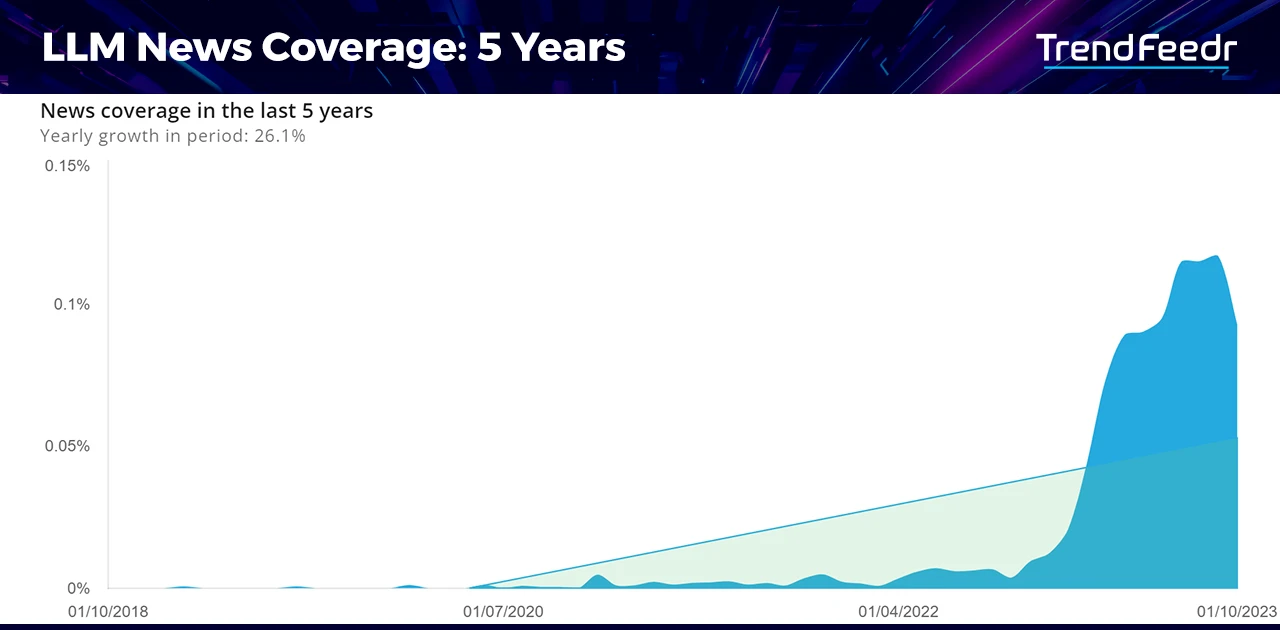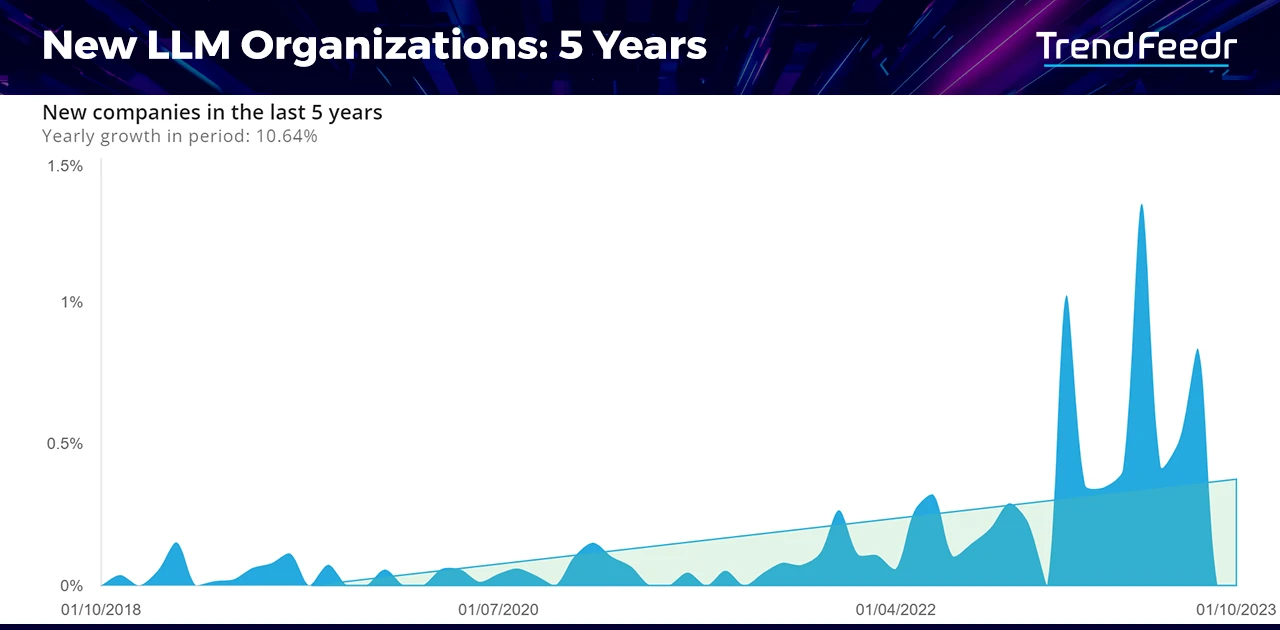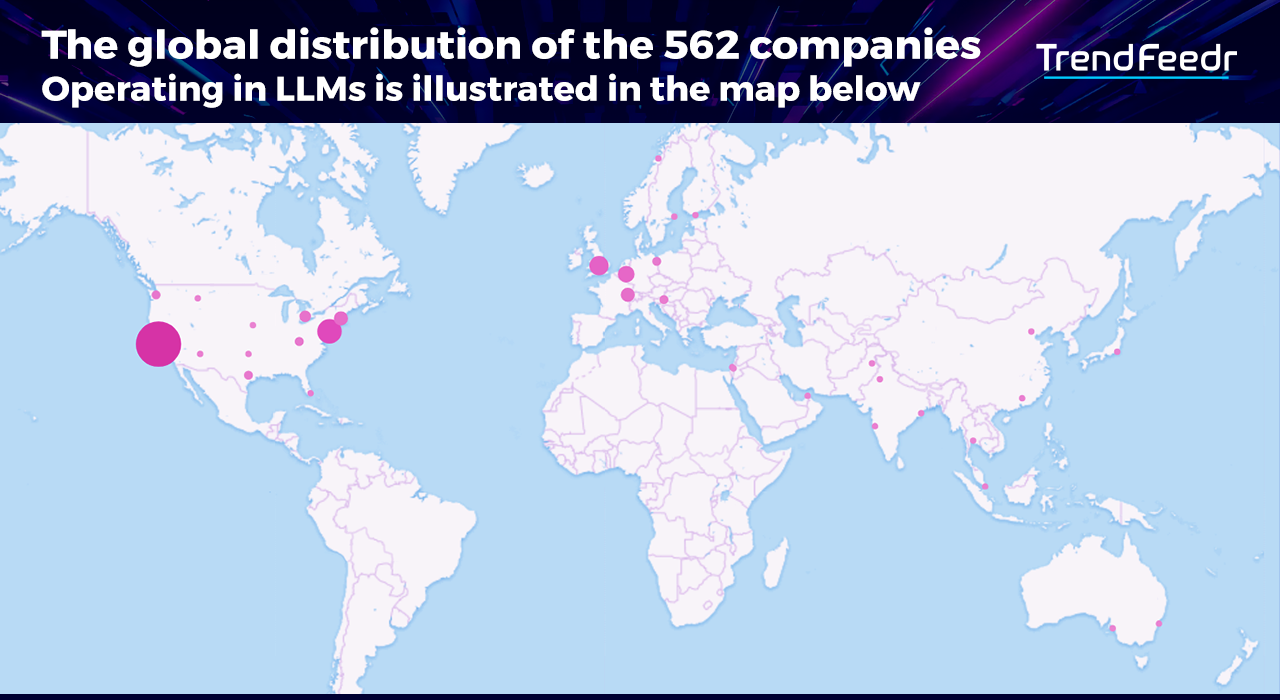Artificial intelligence (AI) has radically transformed our lives and businesses in the past decade, with large language models (LLMs) at the epicenter of this shift. In essence, LLMs are advanced deep learning models that change the way we interact with devices, websites, and information in general. For example, the ordinary autocomplete function on your phone is powered by such large language models. To integrate LLMs into business processes, you need to be on top of how LLMs are evolving in the AI landscape. That is why we are offering you data-driven insights and trend analysis on large language models. This technology research focuses on LLM trends, investments in LLMs, geographical activity of LLMs, and more.
For this in-depth research of LLM trends, we leverage TrendFeedr, our all-in-one trend management platform. TrendFeedr identifies future industry and tech trends via advanced, proprietary algorithms. With a focus on trend discovery, clustering, and analysis, the AI-powered platform screens thousands of trends each month to track their development and curate actionable insights.
Remarkably, out of all 20,000+ trends and technologies that TrendFeedr covers, LLMs have made a significant mark. Here’s why:
- Over the last three months, LLMs took the number one spot, and throughout the year, they secured the second spot overall.
- Looking back over the past five years, LLMs consistently ranked among the top 12 trends.
- The trajectory steepened ever since GPT3 became available, especially with the public launch of ChatGPT, an advanced version of GPT3, often referred to as GPT3.5.
Read further to explore what LLMs are, their role in driving innovation and value, and their future prospects based on the latest data and large language model trends from TrendFeedr. This allows you to understand LLMs’ rich history and powerful impact on various domains. As a result, you are able to anticipate and navigate the future of AI more effectively.
Key Takeaways:
- LLMs rank in the top 14% of all 20K+ trends covered by TrendFeedr, with an annual growth rate of over 90%, a trend magnitude of 85.05%, and a trend maturity of 24.5%.
- Approximately, 562 organizations are engaged with LLMs, with a total funding of $18.2 billion.
- LLM companies are also involved in other emerging trends like Neural Machine Translation, Voice Intelligence, Transfer Learning, Machine Learning as a Service, and Automated Speech Recognition.
- Key investors include Microsoft, Tiger Global Management, and Section 32.
- The United States, India, China, Canada, and Germany take the lead in LLM adoption.
- Media exposure for LLMs increased 30-fold in 2023 alone.
Table of Contents
- Understanding LLMs: The Key Drivers of the AI Revolution
- Trend Performance Analysis of LLMs
- Investment Landscape of LLMs
- LLMs – Geographical Activity Overview
- Companies’ Involvement in Driving LLM Trends
- How Large Language Models Disrupt Industries
- Future Outlook of Large Language Models
Understanding Large Language Models: Key Drivers of the AI Revolution
What is a large language model?
LLMs understand, generate, and interact with human language in a strikingly intuitive manner. They combine deep learning and natural language processing (NLP), encapsulating a complex interaction of data, algorithms, and computational power. LLMs belong in the larger category of generative AI Trends, as they have the ability to create new, original content.
How do large language models work?
Trained on vast volumes of text data – mostly from the Web – LLMs learn language patterns, subtleties, and structures. This way, LLM models generate human-like text to answer questions, compose essays, create poetry, and competently write code. A core emergent property of these models is their ability to provide reasoning to various tasks.
LLMs are based on transformer architecture, also known as the large language model transformer. It utilizes multiple layers of self-attention and feed-forward neural networks. This way, an LLM transformer captures and processes different aspects of the text to retain attention to key parts within a text corpus.
What are different large language models?
Examples of large language models range from simple models like ELMo (one of the first large language models) and OpenAI’s GPT-1 to more advanced versions like GPT-3 and GPT-4, the most popular large language models. This history of large language models shows the enormous transformation in the field of LLMs. They demonstrate unparalleled language comprehension and generation capabilities.
For instance, popular large language models such as Google’s LaMDA engage in more open-ended and natural conversations, whereas its PaLM enhances the comprehension of sentence structures and meanings. These are just a few examples from the large language models list.
Perhaps most surprising is the vivid open-source community, which has generated various open-source AI language models. In many cases, they are also licensed to be commercially available. Notable open-source models amongst many others are Falcon-Instruct (7B), Vicuna(13B), and MosaicML (MPT-7B).
What are the capabilities of large language models?
Large language model use cases span both commercial and open-source applications. Such LLM applications involve tasks such as content generation, sentiment analysis, chatbots, translation, and even complex problem-solving across sectors. They leverage their learned knowledge and context to understand and generate language, enabling task automation. Further, the benefits of large language models include enabling businesses to extract insights from vast volumes of unstructured text data and enhance decision-making in many areas.
Trend Performance Analysis – The Rise and Impact of LLMs in the AI Sector
Undoubtedly, LLM trends are a key advancement in AI and machine learning, opening up new possibilities in the large language model landscape. Let’s explore how they are transforming the current trends in AI.
Large Language Models Trend Card
Introducing TrendFeedr’s Trend Card, your compact guide to navigating the trend landscape, in this case, the LLM trend landscape.
From the image, you see that LLMs are among the most promising emerging technologies in the world, ranking in the top 14% of all trends covered by TrendFeedr. They have an annual growth rate of over 90%, contributing to the large language models market size. This is determined by combining the growth in the organizations involved and the growth in news coverage of the topic.
With a trend magnitude of 85.05% and a trend maturity of 24.5%, they have a strong potential for further development and impact. But that’s just the tip of the iceberg. Our Trend Card goes beyond these key metrics, offering a well-rounded view of the LLM landscape. Learn about the data of organizations working on LLMs and the human resources dedicated to this field.
Moreover, we analyze the financial aspects, such as funding in large language models, growth, and revenue to identify the major investors that are supporting this trend. You will also discover the impact of large language models across industries, countries, and cities, giving you a global perspective of their potential.
Intrigued? Stay with us as we unpack the story behind these numbers and reveal why LLMs are the key players in the AI boom.
Looking for all trends related to AI and LLM?
LLMs’ Media Exposure Experiences a 30-fold Surge
LLMs have become a significant phenomenon in the business domain and also in the news and media sector. The number of articles written about LLMs demonstrates the growing academic and professional interest in this field, landing this trend among the top 10% of all trends covered on TrendFeedr. And, their media exposure in 2023 has increased by 30-fold. Moreover, counting the publications that explore LLMs, the trend ranks in the top 5% out of all topics covered in the news ecosystem.
The time series chart you’re looking at represents the average monthly news coverage related to LLMs. It has seen substantial growth since 2023. These graphs depict that the LLM trend is accelerating, transforming sectors and indicating a new era of AI innovation. Further, the news growth for LLMs ranks impressively among the top 5% of all trends.
Organizations Pioneering Large Language Models
The relevance and potential of LLMs have drawn the interest of many organizations. Approximately 562 entities have declared their active engagement with these advanced AI systems.
This ascending pattern represents a 10.64% monthly growth in the number of new organizations actively engaging with LLMs over the last five years.
Here’s a compilation of the top 7 new organizations leveraging LLMs:
Moreover, the chart shows how LLMs have become a game-changer and a catalyst for innovation. Further, the growth in organizations working with LLMs places this trend among the top 10% of all 20.000+ trends covered by TrendFeedr.
Unpacking the Investments in Large Language Models
LLMs attract a diverse range of investors, indicating a high level of demand. Large language models rank in the top 15% of all trends covered in TrendFeedr, in terms of investment interest. Microsoft, a prominent player in the field, has invested an impressive $10 billion in OpenAI, demonstrating its strong commitment to the development of LLMs.
Tiger Global Management has also made significant investments, allocating $325 million in this sector. This includes an investment of $200 million in Moveworks and $125 million in Cohere. Section 32, another key investor, has distributed $215 million among various LLM-focused ventures, including an investment of $165 million in Cohere AI funding and $50 million in Inworld.
The funding for ventures focusing on LLMs experienced substantial growth in the last five years. This reflects the increasing financial support for LLMs and the recognition of their ability to bring about significant changes.
Analyzing the manpower involved further offers intriguing insights. LLMs have a total manpower of 26.3K, with an average of 67 employees and a median of 13 employees per company. This reveals the key role of a few players, such as Open AI, in advancing LLMs with many smaller teams following closely behind.
The LLM domain has seen a remarkable increase in investment activity compared to the previous years. More than that, the 10 top-funded AI startups have reached unicorn status, with valuations of $1 billion or more, contributing to the generative AI market size.
Monetary Backing of Large Language Model Companies
One of the most notable figures comes from OpenAI’s valuation. With $29 billion, OpenAI has positioned itself as one of the top generative AI startups globally.
TrendFeedr aggregates and analyzes all large language model funding data. Based on this data, the total funding involved in LLMs is approximately $18.2 billion. Breaking down this total reveals that the maximum funding for an individual project stands at $10 billion funding for OpenAI by Microsoft. The average funding amount is $112 million, with a median value of $4.3 million.
Another key figure is the funding activity in the first two quarters of 2023. Out of all the large language model startups in the marketplace, it is notable that the smaller LLM startups secured an impressive $460 million across 63 deals.
Also, the funding growth for LLMs places it among the elite top 5% of all trends. Likewise, the total funding for LLMs positions it among the top 4% of all trends.
Shifting our attention to revenue generation, from our data points, TrendFeedr projects that LLMs have contributed to a remarkable $2.1 billion in total revenue. And, the average revenue of entities leveraging LLMs is $5.4 million.
Moreover, a brief analysis of the generative AI funding patterns of companies reveals five prominent types of funding sources. Seed and early-stage venture capital or Series A funding are the most common, indicating the emergence of many LLM initiatives. Accelerator and incubator programs offer vital early support, while grants foster further innovation. Later stage VC or series C funding rounds are also significant, supporting more mature LLM ventures.
Geographical Activity: Mapping the Global Adoption of Large Language Models
The global distribution of the 562 companies operating in LLMs is illustrated in the map below.
Interested to explore all 560+ LLM companies?
The global landscape of large language models reveals that the United States takes the lead, with both established and emerging companies adopting LLMs. India is also a key player with its abundant talent. In China, substantial investment in AI drives LLM progress while Canada’s AI research centers, the cradle behind our current AI boom, keep contributing to LLM development. Further, Germany’s robust research and industrial base support LLM adoption.
Key cities shine as well in the LLM panorama. San Francisco’s tech-oriented culture drives the demand for LLMs, while New York City’s diverse industries require LLMs for various applications. London incorporates LLMs to capitalize on its financial and tech leadership, and Toronto’s thriving AI ecosystem supports LLM innovation. These areas are leading the way for LLMs, creating an AI revolution with enormous benefits for us all.
How Companies are advancing the LLM Trends
Large language model companies are breaking new ground in their field and also making significant progress in other cutting-edge trends. Here’s an exclusive overview of their diverse involvement in driving LLM trends – based on data from TrendFeedr:
- Neural Machine Translation (NMT)
- This technology uses neural networks to translate text between languages.
- 170 organizations are involved in NMT and have received approximately $479.6 million in funding.
- These organizations also employ over 30 500 people to enhance NMT capabilities.
- Voice Intelligence
- 63 organizations are working with voice intelligence, which extracts insights from voice data.
- These companies have received $476.9 million in funding and have a combined workforce of 2527 people.
- Transfer Learning
- This trend involves transferring knowledge from one task to another, saving training time.
- It has attracted 132 organizations, and they have received $125.9 million in funding – with a total workforce of 2227.
- Machine Learning as a Service (MLaaS)
- 203 organizations make MLaaS solutions that deliver machine learning tools via cloud-based services.
- With total funding of $307.4 million, these companies employ around 5203 people.
- Automated Speech Recognition (ASR)
- ASR technology converts spoken language into written text.
- It has attracted the attention of 87 organizations and has received an impressive $1.7 billion in funding with a total workforce of 13 000.
From neural machine translation to automated speech recognition, LLM companies are at the forefront of innovation. The data from TrendFeedr paints a compelling picture of the industry’s growth and the immense potential that lies ahead.
With hundreds of organizations involved in these trends, millions in funding, and a workforce in the tens of thousands, the scale and impact of these advancements are remarkable. As we continue to monitor these trends, we look forward to seeing how these companies will further revolutionize the field of large language models.
How Large Language Models Disrupt Industries
Large language models – with their ability to decipher, emulate, and reason with human language – are creating transformative outcomes in diverse sectors. Let’s take a look at how different industries are benefitting from large language models.
Healthcare
The healthcare industry is integrating large language models to improve patient communication and disease diagnostics as well as medical research. LLMs are driving the development of intelligent virtual health assistants that understand complex patient queries and deliver accurate information.
Further, LLMs allow healthcare institutions to process vast quantities of medical literature, identify patterns, and contribute to medical research and diagnosis. For instance, GatorTron is a large language model for electronic health records (EHRs) that improves healthcare delivery.
Finance
In finance, LLMs are streamlining customer interactions through AI-powered chatbots. They also enable banks and non-banking financial companies (NBFCs) to analyze complex financial reports, identify trends, and generate insights that guide investment strategies.
Moreover, large language models primarily find use in finance for risk assessment and fraud detection.
Retail and E-commerce
Retail and e-commerce businesses are utilizing large language models for personalized product descriptions, offering customer recommendations, and improving customer service.
As a result, LLMs play a key role in tailoring shopping experiences, answering queries, and even assisting customers in making informed purchasing decisions.
Education
In the field of education, LLMs are revolutionizing learning experiences. They are enabling the creation of personalized study materials and tutoring support as well as aiding essay grading.
Large language models in education also enable interactive learning experiences, paving the way for AI-powered education platforms.
Software Development
Within the software sector, LLMs are accelerating software development by autogenerating code and debugging. They are also improving the user experience by powering intuitive voice assistants and improving natural language search capabilities.
Business/Productivity
LLMs are reshaping the landscape of business and productivity software. They’re powering smarter workflow automation tools that understand and generate language-based tasks. This increases productivity and efficiency in the workspace.
For example, some LLM applications autogenerate responses to customer emails or draft complex reports.
Research
With emergent autonomous scientific research capabilities of large language models, they are becoming essential tools for handling large amounts of data. They process complex research reports, identify main points, and create concise summaries.
LLM software for scientific research accelerates the research process and contributes to more informed decision-making by quickly sifting through massive datasets and identifying patterns or trends. LLMs are also being employed to generate hypotheses and design experiments, thereby catalyzing innovation in this space.
From healthcare to finance, retail, education, technology, businesses, and research, LLMs are reshaping business models, processes, and customer interactions. The potential of large language model trends to transform these sectors is remarkable, highlighting the need to comprehend their capabilities and implications.
Future Outlook of Large Language Models
As we look ahead, trends in large language models are transforming various sectors and global markets. They are experiencing rapid growth, fueled by rising investments and expanding adoption across industries. Here’s what you can expect in the future of LLM landscape:
1. Greater Investment and Global Adoption
Our trend data suggests a sharp increase in both funding and the number of organizations working with LLMs. This trend is likely to continue, with more businesses recognizing the transformative potential of LLMs and allocating more resources to their development and application.
Further, we anticipate increased adoption across various geographies beyond the current major players, contributing to a truly global LLM ecosystem.
2. Evolving Applications Across Diverse Industries
The future of large language models will involve permeating a broader array of industries, from healthcare and education to entertainment and logistics. Businesses will uncover novel uses for LLMs, disrupting traditional models and driving innovation.
3. Increased Regulatory Attention
LLMs are likely to attract increased attention from regulatory bodies. Issues such as data privacy, algorithmic bias, and ethical AI use will become central in the conversation surrounding the technology. Organizations will need to navigate these considerations while developing and deploying them.
4. Democratization of AI
The trend data indicates that there are a significant number of small businesses working with LLMs. We may see an increase in small and medium-sized enterprises leveraging these models to enhance their operations and offerings, contributing to the democratization of AI.
Open-source LLMs and other generative AI models also play a crucial role in making the technology more accessible.
5. Enhancing Human-Machine Interaction
We can anticipate more sophisticated and seamless interactions between humans and machines. This progress will lead to more intuitive interfaces, efficient customer service, personalized experiences, and increased accessibility for users with varying needs.
6. Disruption and Creation of Jobs and Skill Requirements
The rise of LLMs will likely fuel the creation of new job roles and skill requirements as well as disrupt existing job profiles. Expertise in managing, interpreting, and applying LLMs will be highly valued, and upskilling or reskilling in relevant areas will become a priority for many professionals.
How Will You Navigate the Evolving Landscape of LLMs?
As we conclude our journey through the current trends in LLMs, it is clear that we are navigating an ever-evolving landscape. The pace of innovation is rapid, and the potential for transformation is immense.
Staying on top of these trends is essential as it allows you to anticipate changes, seize opportunities, and stay competitive in a field that’s shaping the future of technology. But how can you do this?
Networking with industry professionals, thought leaders, and innovators provides unique perspectives and opportunities for collaboration. Read industry reports, attend webinars and conferences, and participate in relevant online communities to get an overview of the technology. Lastly, leverage a trend intelligence platform, like TrendFeedr, to keep up with emerging trends in large language models, and other relevant technologies like generative AI.
These activities will enable you to identify the latest developments in large language models to streamline your investment and business strategies.
